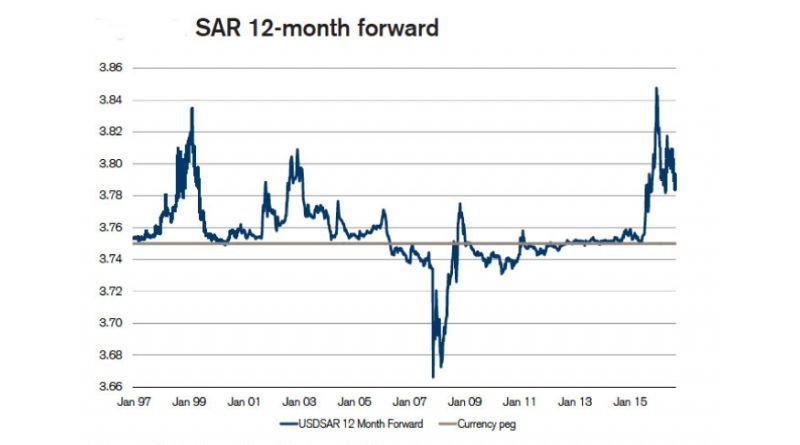Saudi Arabia Can Avoid Any Devaluation: Study

JEDDAH — Saudi Arabia has enough tools at its disposal to avoid any devaluation in the foreseeable future, Credit Suisse Research on Saudi Arabia released Wednesday revealed.
Foreign exchange reserves are 15% lower YoY and 23% lower than their mid-2014 peak, but at about $550 billion, the reserves are still close to 100% of GDP and provide adequate cushion for defending the peg. This number does not include Saudi Arabia’s holdings of US treasuries totaling $96 billion (down from recent peak of $124 billion in January 2016).
“We believe this number significantly understates Saudi Arabia’s full holdings of treasuries, much of which are likely to be with external managers.
the dollar peg also plays an important role in the credibility of the central bank and its monetary policy.”
A devaluation could destabilize the financial framework of the country (and by extension, of the broader Gulf region as well) and, in a worst case scenario, it could trigger significant capital flight.
pressure on the Saudi riyal’s (SAR) peg to the US dollar has remained well above the long-term average. Even the announcements of far-reaching reforms have only served to reduce but not eliminate speculative calls against the peg. In part, this is due to the low-cost nature of such positioning: downside is limited to 1% at present, while upside could be significant in case of devaluation.
“We believe concerns about the peg are misplaced and that the risk of devaluation is negligible. There are two primary reasons for our conviction. First, the political and economic costs are far too high. A devalued riyal would certainly reduce fiscal deficit, but at the cost of significantly higher imported inflation.” Keeping consumer prices under control has always been a priority in Saudi Arabia and has become all the more so since the Arab Spring. We would therefore expect the government to avoid any policy that could result in basic necessities becoming materially more expensive.
Meanwhile, the Kingdom enjoys one of the lowest debt-to- GDP ratios in the world, which is expected to jump to a 10- year high of 17% this year as Saudi Arabia issues its first international bond, expected to be $15 billion.
“We expect debt-to-GDP levels to reach toward 50% by 2020/21, in line with the government’s guidance. This translates to a heady issuance of roughly $400 billion from end- 2015 levels. Appetite for Saudi papers remains robust, but such a huge pipeline of issuance in a relatively short timeframe will undoubtedly push up the cost of borrowing eventually. However, we believe the increased debt will be sufficient to cover budget deficits in the coming years.”
Earnings estimates have been slashed since oil prices collapsed in mid-2014. The scale of change is particularly notable when one considers how stable and closely correlated forecasts were across sectors in the preceding period. Surprisingly, the sector witnessing the largest downward adjustment has been telecoms. However, this is entirely a reflection of Saudi Telecom Co (STC) which has disappointed on earnings for the past five consecutive quarters due to rising competition and regulatory reforms-driven price decreases. However, with the top-line remaining resilient and surprising positively for the most part, we believe the downgrades appear to be overdone. The next most heavily downgraded sector has been petrochemicals. Notably, however, neither earnings nor price performance has reflected the sharp recovery in oil prices this year. With our more positive outlook on oil prices, we believe earnings forecasts should improve going forward.
At the opposite end of the spectrum, the retail sector has shown surprising resilience. However, this is a reflection of the sector’s constituents which feature a large number of healthcare services companies. Stripping out just the key consumer discretionary names reveals that earnings downgrades have indeed been substantive year-to-date. However, with subsidy reforms being underway, we remain cautious on the outlook for earnings and see the risk of a renewed (albeit more modest) cycle of downgrades.
Consumer spending remains under pressure. Worryingly, the seasonal pick-up in spending over summer does not appear to have been a factor this year.
Both agriculture (primarily dairy companies and consumer staples names) and banks have seen relatively modest downgrades. The former seems sensible, but we still see sizeable downside risks to banks’ earnings.
“For the latter, we believe the modest scale of downgrades has much to do with the lack of meaningful developments in non-performing loans. We would expect to see an increase on this front in H2 2016 earnings numbers.
Moreover, we remain concerned about tightening liquidity conditions as reflected by the increased loan-to-deposit ratios and rising interbank rates. The diffi- Stay cautious; await clarity on upgrade to emerging market status 3 cult banking sector environment is not unique to Saudi Arabia, and we are cautious about the sector across the Gulf region as a whole,” Credit Suisse research noted.
(Source: SaudiGazette.com.sa)


